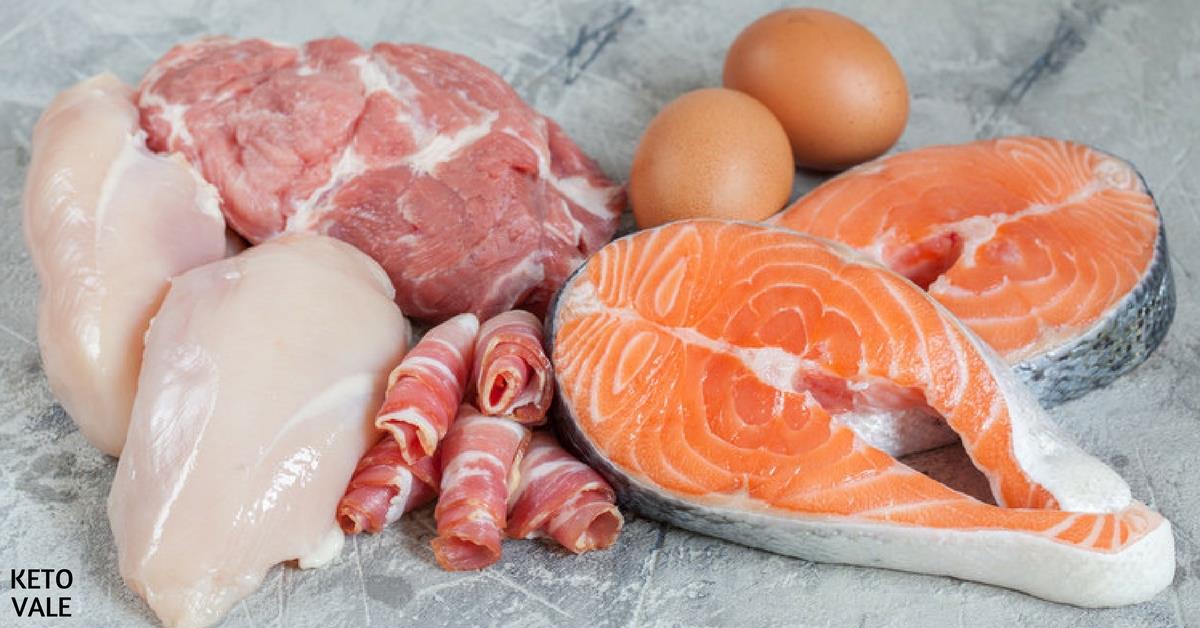If you haven’t heard, getting into ketosis is good for you. In fact, the ketogenic diet is rapidly becoming one of the most popular diets in the world, and with good reason.
Using fat as the main source of fuel for your body? Sign us up!
However, it isn’t as easy as it may sound. While the concepts are fairly simple, the application can be rather difficult, especially if you have to eliminate those pesky bad habits.
Getting into ketosis – and staying there for a prolonged period of time – can be quite the challenge…
The truth is, there are multiple ways you can get your body into ketosis lightning fast, so you get more bang for your fat-burning buck.
Here, we’ll go over the top six strategies you can implement in your life to easily get into ketosis.
We’ll also explain what ketosis is, how long it takes the average person to get into ketosis, the benefits, and how to tell when you’re finally in that sweet spot.
Let’s get to it!
What is Ketosis?
Ketosis, is using a different source for fuel than what your body is built to use.
It’s a normal metabolic process so that your body doesn’t shut down when glycogen – your main energy source – is depleted.
When you eat food (specifically carbohydrates and ample protein), the calories are turned into glycogen, which is subsequently burned for energy in your body.
However, after a solid fast from these energy sources, your body loses its glycogen stores.
So, instead of burning carbs and glycogen, your body turns to fat cells. This starts the process of ketosis.
Your body creates ketone bodies or ketones, which is part of the fat cell’s breakdown. Ketones become the next best replacement for glycogen, while the fat cell is stripped of its mass.
Essentially, ketosis mobilizes fat for energy when glycogen stores are low or nonexistent.
Normally, your body doesn’t make ketones. This is due to glycogen being a simpler, easier source of energy your body can use on the regular.
However, if you strip your body from those glycogen sources and go with a high-fat ketogenic diet, your body will be forced to use ketones.
While in ketosis, your body is using its fat storage as fuel.
Your body thinks you’re starving for glycogen, so it takes the stored energy – which is the literal function for fat – and uses it.
You should experience a loss in body fat percentage and weight overall. (Other benefits are covered below.)
6 Tips To Get Into Ketosis Fast

It may sound difficult to get into ketosis. I mean, how could you possibly cut carbs to such a drastically low level? And protein, too?
Luckily, there are certain tricks you can utilize to make ketosis an easier process to get into and stay in. Here are the top six:
1. Minimize Carb Intake

Obviously, this is the first step you need to take no matter what if you want to reach ketosis.
Minimizing carb intake can be tough as hell, but there are good hacks to begin cutting back:
- Avoid drinking your calories. Odds are, if you’re drinking something with calories, it’s from sugar, which is a simple carb with absolutely zero nutritional value. Water, black coffee, tea, and other zero-calorie beverages are your best bet (but avoid sugar substitutes at all costs as well).
- Get more vegetables in your diet. Now, leafy greens and other veggies are technically carb-centric, but they are incredibly low in calories. When you begin a ketogenic diet, what’s usually prescribed for carbohydrates are low-calorie vegetables and a handful of berries (not any other fruit). Luckily, berries and veggies can fill you up and help you avoid feeling hungry.
- If you have to ask, don’t eat it. There are some foods that are in this carb-fat-protein grey area, where they have almost level amounts of each. A general rule of thumb is, if you have to ponder or if it isn’t an immediate go for it, then you shouldn’t eat it if you want to remain in ketosis.
This is the most difficult part of going ketogenic. If you can get to a sub 50-gram limit for carbs, you’ll be well on your way to full ketosis.
2. Increase Healthy Fat Intake

By far the mainstay of the ketogenic diet and getting into ketosis, fats are critical for your wellbeing and caloric needs.
Seeing as at least 70% of your calories should be coming from fats, you need to fill your diet with fats.
Thankfully, a gram of fat gives you 9 calories (compared to 4 per gram of carbohydrate or protein), so you don’t have to go to crazy lengths to get your fat.
Now, as with all diets, you can eat a healthy version of the diet or an unhealthy, junk version.
Vegans have heavily processed fake meat products. Gluten-free individuals have their own chips, cookies, and other refined foods.
Ketogenic diets are similar. Technically, you can eat foods high in trans fats and saturated fats and remain in ketosis. However, you will feel the repercussions, both physically and mentally.
The key is to increase your healthy fats. These include:
- Omega-3 fatty acids (salmon, chia seeds, walnuts, flax, Brussels sprouts, etc.)
- Other polyunsaturated fatty acids (PUFAs; fish, sunflower seeds, various oils, etc.)
- Monounsaturated fatty acids (MUFAs; nuts, avocado, oils, nut butters, etc.)
- Saturated fats (dairy products, coconut oil – and anything coconut – and dark chocolate)
Of course, certain oils are healthy and wonderful for you. Cook with foods like MCT oil, cold-pressed coconut oil, palm fruit oil, olive oil, macadamia oil, flaxseed oil, or avocado oil.
Then there’s the truly incredible aspect of this diet: You should focus on increasing your butter or ghee intake.
All of these fats – oils, butters, nuts, seeds, avocados, and some veggies – are necessary to get the right amount of calories everyday while in ketosis.
3. Include MCT Oil In Your Diet

As we discussed briefly in the previous tip, MCT oil is tremendous for getting your caloric needs met while staying healthy with your fat choices.
But MCT oil does a hell of a lot more than you might think…
(We’ve actually covered the amazingness of MCT oil before; for a full breakdown, read here.)
In a nutshell, it’s the medium-chain triglycerides derived from coconut oil. It offers a slew of benefits, such as:
- Increased weight loss or maintenance
- Improved energy levels and mood
- Supported digestion and nutrient absorption
- Protected heart health
- Has antibacterial, antiviral, and antifungal properties
- Can be cooked at a high heat
This is a powerhouse cooking oil, and can also be used as a supplement.
In terms of ketosis, it would be prudent to use MCT oils as often as you possibly can: Putting it in your coffee to make it Bulletproof, cooking vegetable stir-fry meals in coconut oil, and adding it to sauces or dressings.
MCT oils skyrocket your fat loss, which is the main goal of ketosis anyways. So include them into your daily routine.
4. Increase Physical Activity

This might sound counterintuitive: Wouldn’t additional workouts and movement trigger more hunger, which could potentially lead to a carbohydrate cheat to end all cheats?
Well…yes. But if you have the other tricks established and you’ve escaped the innate desire to cram as many carbs as possible into your mouth, extra effort in physical activity works like gangbusters for ketosis.
The more you work your body physically, the more calories it burns (duh).
When this happens, your glycogen stores from limited carbs or previous glucose ingestion depletes faster.
You can effectively bring yourself into ketosis by working out or playing sports.
Not only that, but you also get that “afterburn” effect from HIIT, sports, running, or any other cardiovascular exercise.
The bang for your buck comes after working out; more calories are burned after working out.
If you perform cardio and then remain in ketosis by eating high-fat, you’ll burn more ketones and lose more body fat.
Even though it sounds too good to be true, it makes sense.
Your body burns the easiest available energy.
If you have zero glycogen, then it’s ketones. And when you workout hard, your body burns more energy. Therefore, it burns more fat.
Any form of exercise can accomplish this, but in descending order these are the optimal ways to burn fat while in ketosis:
- Aerobic exercise (cardio, long duration and low intensity)
- Anaerobic exercise (weight lifting or HIIT, short duration and high intensity; usually burns carbs, so once those are completely gone from your body it’ll begin to burn fat)
- Flexibility exercises (yoga or stretching, helps with range of motion and soft tissue)
- Stability exercises (core or balance training, helps with alignment and body control)
(Just make sure you’re getting enough calories in on a daily basis. A major problem with going into ketosis is most people simply starve themselves without adding enough fats. Then, when they go to workout, they feel lightheaded, dizzy, or pass out. Avoid this and eat your fats!)
5. Consume Adequate Protein

This tip has a very fine line that you really want to toe.
On one hand, not eating enough protein will result in feeling hungry constantly and potentially missing the mark on your daily caloric needs.
On the other hand, eating too much protein on a ketogenic diet will cause your body to convert some of the protein into glycogen, which would take you out of ketosis and defeat the purpose of the diet.
Too much also equates to a slowing of weight loss and less ketones in the bloodstream.
So what’s the magic number?
It depends on your gender, height and weight, age, lifestyle, body fat percentage, and whether you’re in a caloric deficit, surplus, or in maintenance.
A generic goal should be 0.8 grams of protein per pound of bodyweight. This means a 180-pound male should aim for about 145 grams of protein daily.
(To calculate your calories and macronutrients based on your individual stats and goals, check out this calculator.)
Thankfully, you could create a protein range to try and hit each and every day.
Protein is very important in helping you stay full on the ketogenic diet, as well as avoid muscle atrophy. You want to lose body fat, but you don’t want to lose muscle.
For adherence to being in ketosis, it’s vital to get an ample amount of protein in your diet.
6. Fast

A super simple way to get into ketosis is to…not eat. At least for a little bit.
Fasting is a great strategy for your life in general.
Not eating for a period of time longer than 10 hours (the average time Americans fast, mostly due to sleep) provides your body a ton of benefits, like giving your digestive system a break, burning through the fuel you already have in your body, and *shocker* gets you into ketosis.
From the very beginning of your fast, your body is burning energy.
It starts with the glycogen just created from the food you ate.
Once that’s all gone, it moves onto stored glycogen from previous meals.
After that, it searches for more glycogen. When it’s fully depleted, boom! You’re in ketosis.
Fasting intermittently is a wonderful regimen to try out. Basically, you skip a morning meal and push your first set of calories later into the day.
The essential tenant is: Eat breakfast later, eat dinner earlier.
This gives your body more of a break from insulin, digesting, and pulling blood away from other parts of the body.
If you want, you can also partake in 24-hour or 48-hour fasts.
But be careful; you’ll want to know exactly what you’re getting yourself into and prepare accordingly.
We don’t want 36 hours of fasting completely ruined by a fries-and-cupcakes binge immediately following the fast.
From a practical standpoint, fasting and eating high-fat, low-carb are the two biggest factors that go into ketosis.
How Long Does It Take To Get Into Ketosis?

In order to get into ketosis, you shouldn’t be consuming more than 30 gram of carbs per day. In fact, 20 grams is even better.
With this said, for most people it takes 1-3 days to get into full ketosis.
This is due to the fact that you need to use up all of your glycogen before your body begins to make ketones for the main energy source.
Some people take less than 24 hours to enter ketosis, while others can take as long as 10 days. Your timeline will depend on a few factors:
- Metabolism speed
- Amount of carbohydrates consumed daily
- Physical activity level
- Body fat percentage
- Lifestyle
Your body needs to become comfortable with using ketones for energy.
It’s burned sugars its entire life; to switch your main fuel to ketones will take some time.
This is where all of the above strategies – especially intermittent fasting and decreased carb intake – are important for speeding up this process.
Benefits Of Ketosis

There are numerous advantages to changing your diet to a ketogenic one:
- Your appetite gets slaughtered: This is actually a good thing. You don’t get as hungry once you’re fully established in ketosis. When you eat more protein and fat and less carbs, you surprisingly eat fewer calories. And your appetite is downregulated (at least according to this study).
- You lose weight: Probably the reason why we’re all here, ketosis leads to improved fat loss. If you stick to it long-term and create a lifestyle around ketosis, you will experience rapid fat loss compared to other diets.
- Your abs will lose fat: There are two types of fat relative to where it is in the body – subcutaneous and visceral. The first – subcutaneous – is just below the skin and is the easiest to lose. Visceral, however, resides in the abdominal cavity and is between organs. Too much visceral fat leads to inflammation and insulin resistance. Ketosis causes a greater proportion of visceral fat to be lost. Hello, six pack!
- Triglycerides decrease: A fancy word for “fat molecules” that are in your blood. Fasting triglycerides, or the amount found in your blood after a night of fasting, are one of the leading causes of heart disease. These triglycerides are actually created by carbs, the biggest culprit being fructose, or simple fruit sugar. Ketosis obviously solves this problem by taking out carbohydrates and sugars.
- HDL cholesterol is increased: Known as the good cholesterol, HDL takes cholesterol from your entire body and transfers it to your liver, “where it can be reused or excreted.” This can lower your overall cholesterol as well. And what’s one of the best ways to up your HDL levels? Yep, eating fat. Ketogenic diets are fantastic for enhancing your HDL while limiting your LDL as well.
- Blood sugar and insulin are reduced: Keeping carbs out of your body helps you avoid spikes in insulin and blood sugar. This reduces inflammation and keeps you from being insulin resistant, which can lead to Type 2 diabetes and other heart problems.
These are only the top benefits of being in ketosis.
There are a few more, but the gist is this: Ketosis is really good for your body’s overall health.
Read Also:
The Optimal Ketogenic Living Chart
How To Tell When You’re In Ketosis?

A great question, seeing as it can be really tough to know intuitively.
The best way to see if you’re maintaining ketosis is to test your ketone levels.
This is where ketone strips can come into play.
You can do this one of three ways: Through your breath, from your blood, or via your urine.
Your breath carries acetone, a type of ketone that provides a reliable measurement of ketosis within the body.
A meter called the Ketonix meter gives you a strip to breathe on and see how far in you are in ketosis.
For blood, there are ketones called beta-hydroxybutyrate, which can be tested like a glucose meter tests glucose.
All you do is place a small drop of blood on the meter and it reads the ketone levels in the blood.
The issue with blood test strips is they’re expensive.
Finally, urine testing measures the acetoacetate in your pee.
Like all urine tests, when you go #1 you place the test strip into the stream.
Various shades of purple or pink will determine the level of ketones in your urine.
The darker the shade, the more in ketosis you are. (Urinary ketones seem to be highest in the morning and after dinner.)
Conclusion
Getting into ketosis is one of the prime ways you can help your body lose weight and body fat, feel alert and focused, and improve your entire body composition, inside and out.
While reaching ketosis can be a struggle sometimes, using these six strategies will definitely aid you in your mission.
Implement one or more of these tips into your normal routine to boost your ketogenic lifestyle.
They should speed up the process of getting into ketosis, which helps you experience more of the benefits.
Make sure to test your ketone levels to ensure you’re hitting your mark. After that, it’s a matter of remaining ketogenic and healthy.
We wish you the best of luck on your ketogenic quest!

